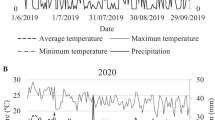Summary
The Ecuadorian national collection ofS. phureja ssp.phureja Juz. & Buk. was evaluated in two parts in consecutive years in the field for resistance toPhytophthora infestans (Mont.) de Bary. Levels of resistance higher than that of the moderately-resistant tetraploid control were found. Preliminary studies indicate that this resistance is a result of minor genes. Three components of resistance: lesion diameter, lesion number and latent period were all correlated with field resistance as measured by the area under the disease progress curve.
Similar content being viewed by others
References
Browning, J.A., 1974. Relevance of knowledge about natural ecosystems to development of pest management programs for agro-ecosystems.Proceedings of The American Phytopathological Society, Vol. 1, pp. 191–199. The American Phytopathological Society, St. Paul, Minnesota, USA.
Colon, L., 1994, Resistance toPhytophthora infestans inSolanum tuberosum and wildSolanum species., PhD Thesis, Agricultural University, Wageningen, Netherlands, 159 pp.
De, Maine, M.J., C.P. Carroll, H.E. Stewart, R.M. Solomon & R.L., Wastie, 1993. Disease resistance inSolanum phureja and diploid and tetraploidS. tuberosum × S. phureja hybrids.Potato Research 36: 21–28.
Forbes, G.A. & M.C. Jarvis, 1994. Host resistance for management of potato late blight. In G. Zehnder, R. Jansson & K.V. Raman (Eds), Advances in potato pest biology and management. American Phytopathological Society, St. Paul, Minnesota, USA, pp. 489–495.
Fry, W.E., S.B. Goodwin, J.M. Matuszak, L.J., Spielman, M.G. Milgroom & A. Drenth 1992. Population genetics and intercontinental migrations ofPhytophthora infestans.Annual Review of Phytopathology 30: 107–129.
Harris, M.K. & R.A. Frederiksen, 1984. Concepts and methods regarding host plant resistance to arthropods and pathogens.Annual Review of Phytopathology 22: 247–272.
Korva, J.T. & G.A. Forbes, 1994. A simple technique for healthy and diseased leaf area assessment of potato plants.Potato Research 38: 31–37.
Oijen, M. van, 1991 Identification of the major characteristics of potato cultivars which affect yield loss caused by late blight. PhD Thesis. Agricultural University. Wageningen, Netherlands, 116 pp.
Spielman, L.J., A. Drenth, L.C. Davidse, L.J. Sujkowski, W. Gu. P.W. Tooley & W.E. Fry, 1991. A second world-wide migration and population displacement ofPhytophthora infestans.Plant Pathology 40: 422–430.
Thurston, H.D., L.E. Hedrick & J.N. Guzman, 1962. Partial resistance toPhytophthora infestans de Bary within the Coleccion Central Colombiana.American Potato Journal 39: 63–69.
Author information
Authors and Affiliations
Rights and permissions
About this article
Cite this article
Cañizares, C.A., Forbes, G.A. Foliage resistance toPhytophthora infestans (Mont.) de Bary in the Ecuadorian natinal collection ofSolanum phureja ssp.phureja Juz. & Buk. Potato Res 38, 3–10 (1995). https://doi.org/10.1007/BF02358063
Accepted:
Issue Date:
DOI: https://doi.org/10.1007/BF02358063




